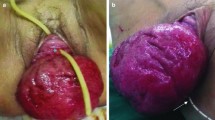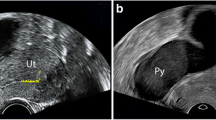Abstract
Pelvic organ prolapse (POP) is the descent of pelvic organs through the vagina, and sometimes causes hydronephrosis. Although the association between POP and hydronephrosis has long been recognized, severe hydronephrosis and renal dysfunction are rarely seen. We report a case of 66-year-old woman who had a vaginal delivery presented with externalized uterine and bladder prolapse during the previous 2 years. She had a 3-day history of hypophagia and vomiting, and laboratory analysis resulted in serum creatinine of 5.75 mg/dL and blood urea of 78.1 mg/dL. The patient was treated urgently with vaginal pessary to return the uterine and bladder into the pelvis. After 2 weeks, her serum creatinine dropped to 3.66 mg/dL, but chronic renal failure persisted. Hydronephrosis caused by POP may lead to renal dysfunction and can advance to irreversible renal damage if left untreated. Important is early evaluation of renal function and images of the kidney and ureter.



Similar content being viewed by others
References
Costantini E, Lazzeri M, Mearini L, Zucchi A, Del Zingaro M, Porena M. Hydronephrosis and pelvic organ prolapse. Urology. 2009;73(2):263–7.
Gerten KA, Markland AD, Lloyd LK, Richter HE. Prolapse and incontinence surgery in older women. J Urol. 2008;179(6):2111–8.
Altok M, Feyzullah ŞA, Umul M, Güneş M. Severe hydronephrosis caused by uterine prolapse with non pecific symptoms and normal renal function. Int J Women’s Health Reproduction Sci. 2013;1(3):111–4.
Kong MK, Bai SW. Surgical treatments for vaginal apical prolapse. Obstet Gynecol Sci. 2016;59(4):253–60.
Jelovsek JE, Maher C, Barber MD. Pelvic organ prolapse. Lancet. 2007;369(9566):1027–38.
Slieker-ten Hove MC, Pool-Goudzwaard AL, Eijkemans MJ, Steegers-Theunissen RP, Burger CW, Vierhout ME. Symptomatic pelvic organ prolapse and possible risk factors in a general population. Am J Obstet Gynecol. 2009;200(2):184.e1–7.
Beverly CM, Walters MD, Weber AM, Piedmonte MR, Ballard LA. Prevalence of hydronephrosis in patients undergoing surgery for pelvic organ prolapse. Obstet Gynecol. 1997;90(1):37–41.
Gemer O, Bergman M, Segal S. Prevalence of hydronephrosis in patients with genital prolapse. Eur J Obstet Gynecol Reprod Biol. 1999;86(1):11–3.
Leanza V, Ciotta L, Vecchio R, Zanghì G, Maiorana A, Leanza G. Hydronephrosis and utero-vaginal prolapse in postmenopausal women: management and treatment. G Chir. 2015;36(6):251–6.
ACOG Committee on Practice Bulletins–Gynecology. Obstet Gynecol. 2007;110(3):717–29.
Bump RC, Mattiasson A, Bø K, Brubaker LP, DeLancey JO, Klarskov P, Shull BL, Smith AR. The standardization of terminology of female pelvic organ prolapse and pelvic floor dysfunction. Am J Obstet Gynecol. 1996;175(1):10–7.
Brettauer J, Rubin IC. Hydroureter and hydronephrosis: a frequent secondary finding in cases of prolapse of the uterus and bladder. Am J Obstet Gynecol. 1923;6:696–708.
Kurt S, Guler T, Canda MT, Demirtas Ö, Tasyurt A. Treatment of uterine prolapse with bilateral hydronephrosis in a young nulliparous woman; a new minimally invasive extraperitoneal technique. Eur Rev Med Pharmacol Sci. 2014;18(11):1657–60.
Melser M, Miles BJ, Kastan D, Shetty PC, Anderson W. Chronic renal failure secondary to post-hysterectomy vaginal prolapse. Urology. 1991;38(4):361–3.
Klahr S, Morrissey J. Obstructive nephropathy and renal fibrosis. Am J Physiol Renal Physiol. 2002;283:F861–F875
Vaughan ED Jr, Gillenwater JY. Recovery following complete chronic unilateral ureteral occlusion: functional, radiographic and pathologic alterations. J Urol. 1971;106(1):27–35.
Shokeir AA, Provoost AP, Nijman RJ. Recoverability of renal function after relief of chronic partial upper urinary tract obstruction. BJU Int. 1999;83(1):11–7.
Lamers BH, Broekman BM, Milani AL. Pessary treatment for pelvic organ prolapse and health-related quality of life: a review. Int Urogynecol J. 2011;22(6):637–44.
Ellington DR, Richter HE. Indications, Contraindications, and Complications of Mesh in Surgical Treatment of Pelvic Organ Prolapse. Clin Obstet Gynecol. 2013;56(2):276–88.
Chevalier RL, Thornhill BA, Wolstenholme JT. Renal cellular response to ureteral obstruction: role of maturation and angiotensin II. Am J Physiol. 1999;277(1 Pt 2):F41–7.
Jones EA, Shahed A, Shoskes DA. Modulation of apoptotic and inflammatory genes by bioflavonoids and angiotensin II inhibition in ureteral obstruction. Urology. 2000;56(2):346–51.
Author information
Authors and Affiliations
Corresponding author
Ethics declarations
Conflict of interest
The authors have declared that no conflict of interest exists.
Human and animal rights
This article does not contain any studies with human participants performed by any of the authors.
Informed consent
Informed consent was obtained from participants included in the article.
About this article
Cite this article
Miyagi, A., Inaguma, Y., Tokoyoda, T. et al. A case of renal dysfunction caused by pelvic organ prolapse. CEN Case Rep 6, 125–128 (2017). https://doi.org/10.1007/s13730-017-0257-2
Received:
Accepted:
Published:
Issue Date:
DOI: https://doi.org/10.1007/s13730-017-0257-2




